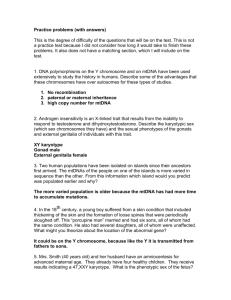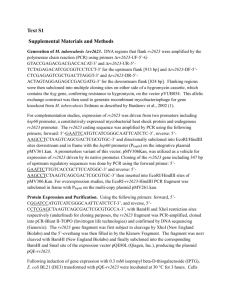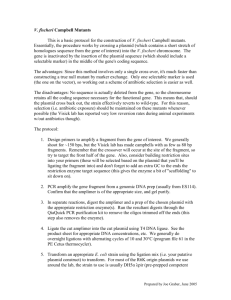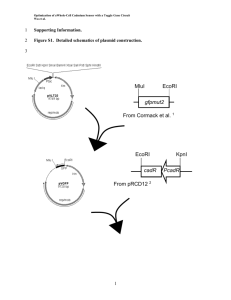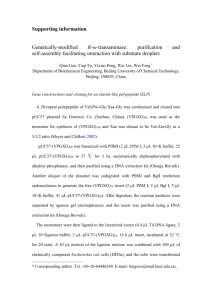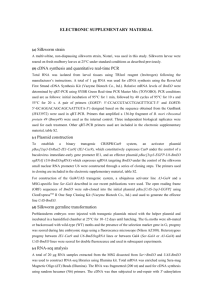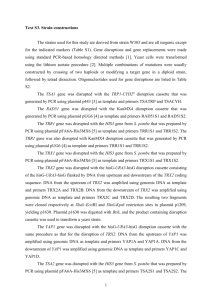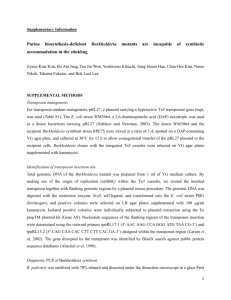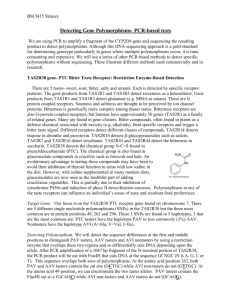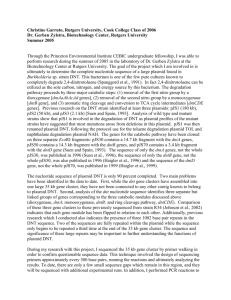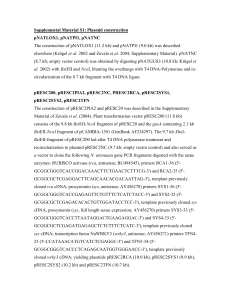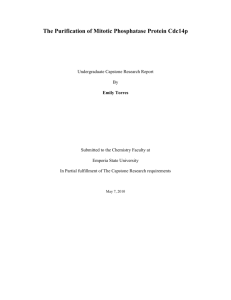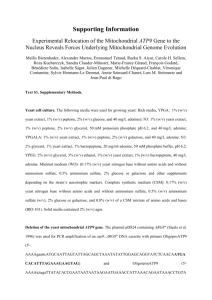Supplementary Information Supplementary materials and methods
advertisement
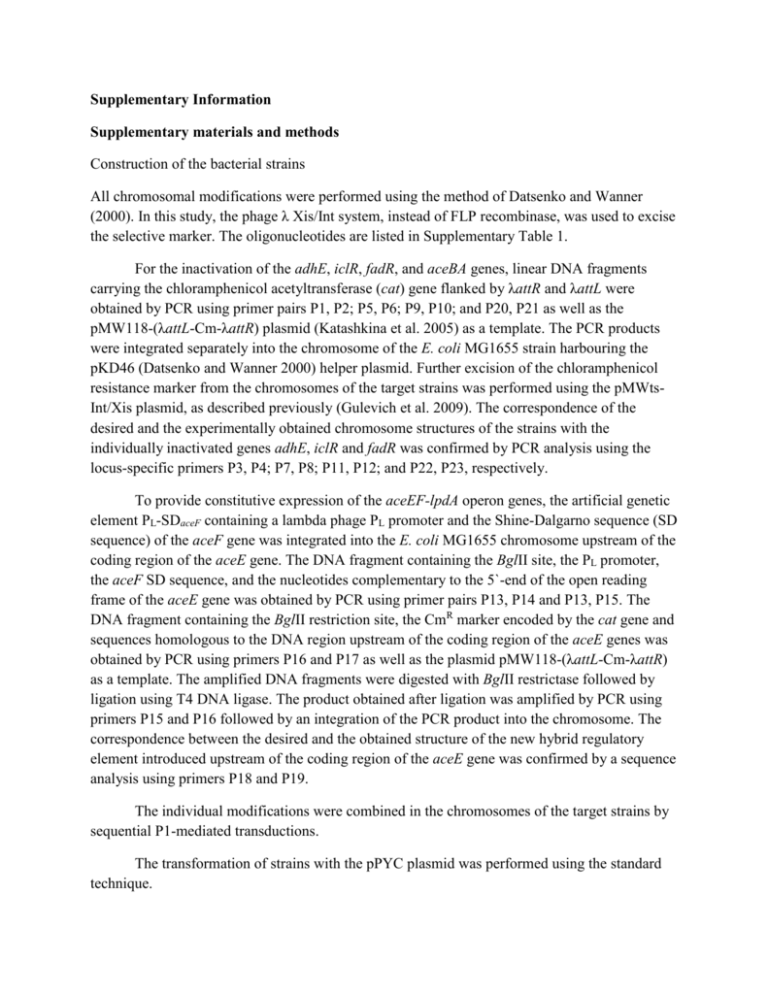
Supplementary Information Supplementary materials and methods Construction of the bacterial strains All chromosomal modifications were performed using the method of Datsenko and Wanner (2000). In this study, the phage λ Xis/Int system, instead of FLP recombinase, was used to excise the selective marker. The oligonucleotides are listed in Supplementary Table 1. For the inactivation of the adhE, iclR, fadR, and aceBA genes, linear DNA fragments carrying the chloramphenicol acetyltransferase (cat) gene flanked by λattR and λattL were obtained by PCR using primer pairs P1, P2; P5, P6; P9, P10; and P20, P21 as well as the pMW118-(λattL-Cm-λattR) plasmid (Katashkina et al. 2005) as a template. The PCR products were integrated separately into the chromosome of the E. coli MG1655 strain harbouring the pKD46 (Datsenko and Wanner 2000) helper plasmid. Further excision of the chloramphenicol resistance marker from the chromosomes of the target strains was performed using the pMWtsInt/Xis plasmid, as described previously (Gulevich et al. 2009). The correspondence of the desired and the experimentally obtained chromosome structures of the strains with the individually inactivated genes adhE, iclR and fadR was confirmed by PCR analysis using the locus-specific primers P3, P4; P7, P8; P11, P12; and P22, P23, respectively. To provide constitutive expression of the aceEF-lpdA operon genes, the artificial genetic element PL-SDaceF containing a lambda phage PL promoter and the Shine-Dalgarno sequence (SD sequence) of the aceF gene was integrated into the E. coli MG1655 chromosome upstream of the coding region of the aceE gene. The DNA fragment containing the BglII site, the PL promoter, the aceF SD sequence, and the nucleotides complementary to the 5`-end of the open reading frame of the aceE gene was obtained by PCR using primer pairs P13, P14 and P13, P15. The DNA fragment containing the BglII restriction site, the CmR marker encoded by the cat gene and sequences homologous to the DNA region upstream of the coding region of the aceE genes was obtained by PCR using primers P16 and P17 as well as the plasmid pMW118-(λattL-Cm-λattR) as a template. The amplified DNA fragments were digested with BglII restrictase followed by ligation using T4 DNA ligase. The product obtained after ligation was amplified by PCR using primers P15 and P16 followed by an integration of the PCR product into the chromosome. The correspondence between the desired and the obtained structure of the new hybrid regulatory element introduced upstream of the coding region of the aceE gene was confirmed by a sequence analysis using primers P18 and P19. The individual modifications were combined in the chromosomes of the target strains by sequential P1-mediated transductions. The transformation of strains with the pPYC plasmid was performed using the standard technique. Analytical techniques The concentrations of organic acids and glucose in the culture media were measured by highperformance liquid chromatography using a Waters HPLC system (Waters). For organic acid measurements, a reversed-phase column ReproSil-Pur C18-AQ (4 x 250 mm, 5 μm, Dr. Maisch) was used with detection at 210 nm. An aqueous solution of phosphoric acid (100 mM) with acetonitrile and methanol (each at 0.5% (v/v)) was used as a solvent, at a flow rate of 1.0 ml/min. For the glucose measurements, a Waters HPLC system equipped with a refractive index Waters 2414 detector and a Spherisorb-NH2 column (4.6 x 250 mm, 5 μm, Waters) was used. The mobile phase contained acetonitrile/ethyl acetate/water in a ratio of 76/4/20 (v/v/v) at a flow rate of 1.0 ml/min. Samples were identified by comparing the retention times with those of the corresponding standards. The amounts of ethanol in the culture media were determined by gas chromatography using a flame ionisation detector. The system consisted of a Shimadzu GC-17A chromatograph equipped with an AOC-20i autosampler. An OmegaWax (Supelco) fused-silica column (30 m, 0.25 mm i.d., 0.25 μm film thickness) was used. Helium was used as the carrier gas at a constant flow of 1.5 ml/min. The column oven was programmed from 40°C (hold 4 min) to 200°C (hold 1 min) at 30°C /min. The split injection mode was used (1:5 split ratio, injection volume 1 μl). The temperature of the injector was 150°C. The detector was maintained at 250°C. Chromatographic data acquisition and processing were performed with Chrom&Spec software. Supplementary Table 1 Primer sequences Primer name Sequence 5`→3` P1 tatggctgttactaatgtcgctgaacttaacgcactcgctcaagttagtataaaaaagctgaac P2 ttaagcggattttttcgcttttttctcagctttagctgaagcctgcttttttatactaagttgg P3 cagtgagtgtgagcgcgag P4 gaagccgttatagtgcctcag P5 aatgaaaatgatttccacgatacagaaaaaagagaccgctcaagttagtataaaaaagctgaac P6 tcagcgcattccaccgtacgccagcgtcacttcctttgaagcctgcttttttatactaagttgg P7 cgaccaccacgcaacatgag P8 gtcagcgcattccaccgtac P9 tatggtcattaaggcgcaaagcccggcgggtttcgccgctcaagttagtataaaaaagctgaac P10 ttatcgcccctgaatggctaaatcacccggcagatttgaagcctgcttttttatactaagttgg P11 gctatcagcgtagttagccc P12 cagcatcgagttgctggaac P13 tgcgacagatctctcacctaccaaacaatgccc P14 tattcttttacctcttaacggccaatgcttcgtttc P15 gatcggatccacgtcatttgggaaacgttctgacattattcttttacctcttaacggccaatg P16 aaaactcaacgttattagatagataaggaataaccccgctcaagttagtataaaaaagctgaac P17 ctagtaagatcttgaagcctgcttttttatactaagttgg P18 gcaactaaacgtagaacctgtc P19 tgagcacgctcaacaccttc P20 gatgactgaacaggcaacaacaaccgatgaactggccgctcaagttagtataaaaaagctgaac P21 ttagaactgcgattcttcagtggagccggtcagcgctgaagcctgcttttttatactaagttgg P22 gaaacgtacctcagcaggtg P23 gccttatccagcctacgttcg Supplementary References Datsenko KA, Wanner BL (2000) One-step inactivation of chromosomal genes in Escherichia coli K-12 using PCR products. Proc Natl Acad Sci USA 97:6640-6645 Katashkina JI, Skorokhodova AY, Zimenkov DV, Gulevich AY, Minaeva NI, Doroshenko VG, Biryukova IV, Mashko SV (2005) Tuning the expression level of a gene located on a bacterial chromosome. Mol Biol (Mosk) 39:719-726 Gulevich AYu, Skorokhodova AYu, Ermishev VYu, Krylov AA, Minaeva NI, Polonskaya ZM, Zimenkov DV, Biryukova IV, Mashko SV (2009) A new method for the construction of translationally coupled operons in a bacterial chromosome. Mol Biol (Mosk) 43:505-514



